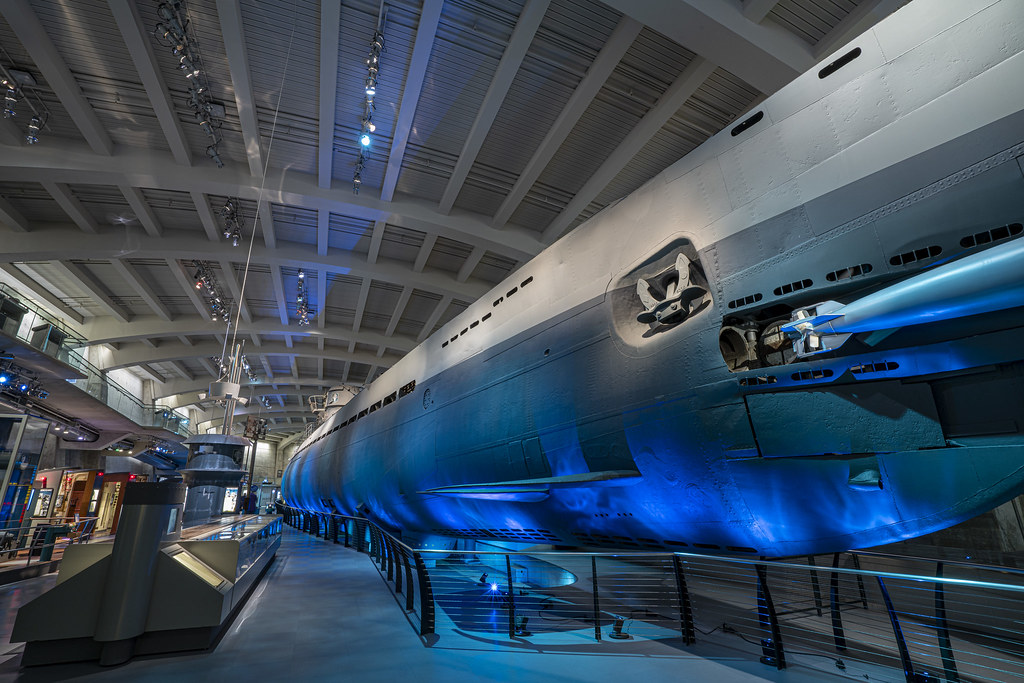The U-505, a German submarine exhibited in the US and that starred in a secret story
The United States is a country that has spectacular museum ships, and one of the best of all is in the city of Chicago.
That ship is a German submarine from World War II, the U-505. This u-boot (as submarines were known in Germany, from the abbreviation of the German word unterseeboot) was laid down in Hamburg on June 12, 1940. Launching took place on May 24, 1941, and it entered service with the Kriegsmarine on August 26 of that year.

U-505 was a Type IXC submarine, with a length of 76.76 meters, a beam of 6.8 meters and a draft of 4.7 meters. Her displacement was 1,120 tons on the surface. She could reach a speed of 18.2 knots (33.7 km/h) on the surface and up to 7.3 knots (13.5 km/h) submerged, with a depth limit of 230 meters.

U-505 was armed with 4 torpedo tubes in the bow and 2 in the stern, and had a total of 22 torpedoes on board. In addition, she had a 105mm SK C/32 deck gun and two anti-aircraft guns: a 37mm SK C/30 and a 20mm FlaK 30. So, she was a very well-armed ship.

After starting her first patrol at the Kiel naval base in Germany, U-505 was assigned to the formidable Lorient submarine base in the Brittany region of France, with such good defenses that the allies had to surround and isolate it, surrendering on May 10, 1945, three days after the German surrender. From that French base, U-505 carried out ten patrols between February 11, 1942 and January 1, 1944, sinking 8 merchant ships with a total of 45,000 tons.

U-505 began her 12th and last patrol on March 16, 1944. 280 km west of Spanish Sahara, a group of US Navy ships detected the presence of the German submarine and launched a hunting operation. U-505 was severely damaged by depth charges, and her crew prepared to abandon her, first opening all the valves for her to sink and leaving her underway. Once the submarine was abandoned and after bringing its crew to safety (except for one of the German sailors, who died in the operation), the allies carried out a rescue operation to seize the U-505.

The US Navy's interest in this submarine was not limited to its technology, but also to something much more important: the ship had an Enigma encryption machine on board along with its codes, which could give a considerable advantage to allies. But for these secret materials to be of any use to the allies, the capture of the submarine had to be kept top secret. To do this, U-505 was "disguised" as a US submarine at the allied naval base in Bermuda, assigning it the name USS Nemo. The Germans, having lost contact with U-505, thought that she had been sunk and left her entire crew for dead.

To keep the capture of the submarine a secret, the crew of U-505 was interned in a prison camp, isolated from the rest of the world and not allowed to contact even the International Red Cross, so that no news would get out of there that could cause the Germans to change their codes. The crew of the U-505 were repatriated to Germany in 1947, two years after the end of World War II.

U-505 was one of six German submarines captured by the Allies and one of only two that survived, and is also the only remaining Type IXC submarine today. Initially, the US Navy thought of using the U-505 as a target for naval shooting, but finally in 1954 the submarine was donated to the Museum of Science and Industry in Chicago, being transferred to that city in July of that year. Initially the ship was exposed outside the museum, but after many years outdoors the hull suffered serious damage, so in 2004 the U-505 was restored and moved to a new closed location within the museum grounds. You can see a video of the impressive transfer operation here:
Currently, U-505 is still on display at that museum , being one of its main attractions. You can see here a video from the channel More Planes showing the ship from the outside and inside:
---
Photos: Museum of Science and Industry of Chicago.
|
Don't miss the news and content that interest you. Receive the free daily newsletter in your email: Click here to subscribe |
- Lo más leído
- A large collection of Volkswagen cars hidden in an abandoned mine in Switzerland
- Sabbione: a beautiful Swiss town that looks like something out of 'The Lord of the Rings'
- The supermassive black hole of Phoenix A, the biggest known light-devouring monster
- An old Soviet military plane abandoned from 1971 on a Russian island near Alaska
- The 'Bomber Glacier': The wreckage of a B-29 on a remote mountain of Alaska
- Ikeshima, a semi-abandoned Japanese island that has post-apocalyptic landscapes
- The MRU, a mysterious underground city of nazi Germany with 80 km of tunnels

 ES
ES





Opina sobre esta entrada: